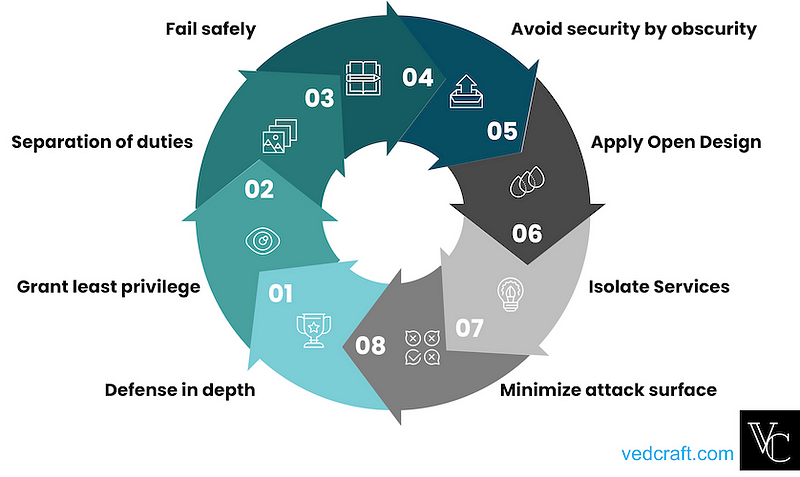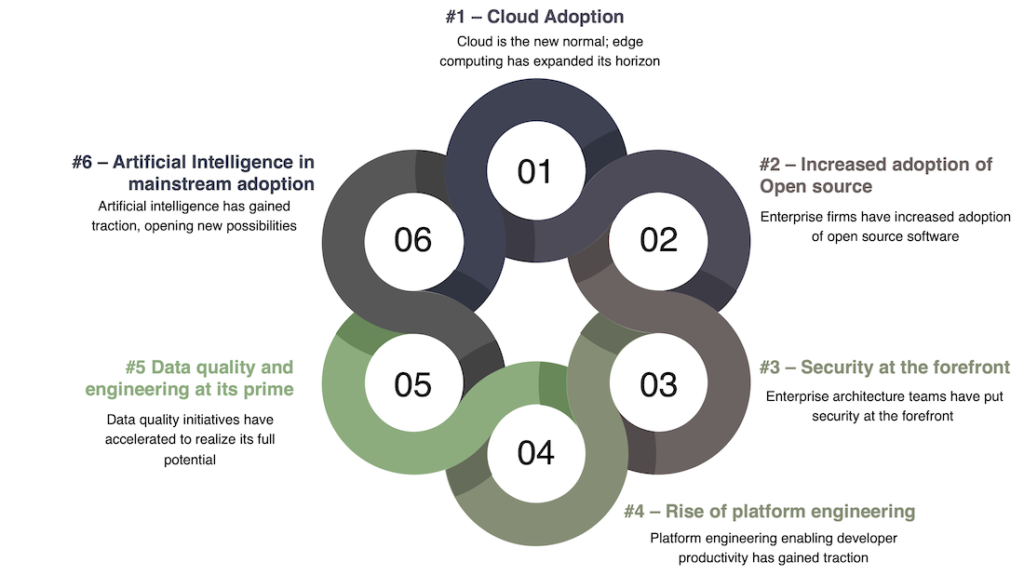2022 has been a phenomenal year from a technology perspective accelerating the adoption of digital transformation across the industry. I published an article at the beginning of the year consolidating top technology trends for 2022. In hindsight, these have been the common trends with the accelerated technology adoption driven by the business demand this year. This article summarizes technical announcements, progressions, and events as observed throughout this year.
#1 — Cloud is the new normal; edge computing has expanded its horizon
Gartner Says More Than Half of Enterprise IT Spending in Key Market Segments Will Shift to the Cloud by 2025 (source link)
While 2023 has seen increased adoption of public cloud platforms, the boundary of cloud has expanded to on-premises with private and hybrid cloud. The maturity model of the cloud will continue to lead towards Cloud-native services, Serverless, Multi-cloud, and Edge Computing.
While data engineering, AI & ML, Serverless, and Developer’s Productivity has been common theme across cloud events, here are key pointers to read further:
- AWS made 2000+ announcements over the year across its 100+ Cloud services spectrum. Read more about key announcements during AWS re:Invent 2022 by clicking here.
- Google Cloud Next 2022 extended its reach to the global audience. Read my article on key takeaways from Google Cloud Next, and the top Google Cloud stories of 2022 by clicking here.
- Microsoft Build for Azure 2022 has demonstrated its continuous growth story with GitHub and OpenAI as key enablers. Read more about key announcements during Microsoft Build by clicking here.
- Oracle has launched Oracle CloudWorld 2022 with 40+ product announcements. Oracle Alloy is an interesting offering enabling partners to be a cloud provider. Read about key highlights by clicking here.
- IBM Cloud has strengthened its cloud services with a key offering in the hybrid cloud with solutions such as IBM OpenShift. Read about their announcements by clicking here.
#2 — Enterprise firms have increased adoption of open source software
IT leaders are choosing to work with enterprise open source vendors. 82% are more likely to select a vendor who contributes to the open source community.
(The State of Enterprise Open Source Report by Red Hat)
- Transparency, community contribution, minimal vendor lock-in, cost-effectiveness, and technology choices have made open source as a compelling option and this year has seen phenomenal growth. Remote work has also helped the cause to increase contribution towards open source.
- Hacktoberfest 2022 by DigitalOcean (a month-long event to encourage contribution to open-source projects) has resulted in 330K+ Pull Request to various projects. Read about key highlights by clicking here.
#3 — Enterprise architecture teams have put security at the forefront
Attack surface expansion, digital supply chain risk, and identity threat detection and response are top three of the biggest cybersecurity trends in 2022.
(Gartner 7 Top Trends in Cybersecurity for 2022)
While 2021 ended with Log4Shell (a zero-day vulnerability), 2022 has increased security awareness in enterprise organizations. In recent times, LastPass data breach and Uber data breach events will continue to reiterate the fact that cybersecurity is on everyone’s radar.
- Black Hat USA 2022 conference highlighted the risks related to MFA, IoT devices, and AI-driven security attacks. Click here to read more.
- RSA Conference 2022 highlighted issues such as privacy and surveillance, AI & ML usage for security attacks, ransomware attacks, supply chain compromises, and much more.
With the above in consideration, Zero-trust security with related practices (see below) and tools/technologies around security have seen tremendous growth in 2022. Security startups and businesses have been the buzz of the town if you’ve been to any technology events.

#4 — Platform engineering enabling developer productivity has gained traction
Platform engineering is the discipline of designing and building toolchains and workflows that enable self-service capabilities for software engineering organizations in the cloud-native era.
(Definition of Platform Engineering)
This year started with concerns of great resignation and one of the key areas of concern was “limited advancement opportunities” triggering organizational initiatives to increase employee retention. Enablement of developers applying platform engineering techniques has been one of the key trends in 2022 with key observations as:
- Internal developer platforms have seen tremendous adoption in 2022 whether using a platform like Backstage or using accelerators built internally. The rise of tools/platforms to enable developers’ productivity in an enterprise has been one of the key highlights of this year.
- DevOps journey (which has always been more of a culture change) continued to mature with the adoption of GitOps, which provides tools and frameworks for infrastructure automation and application deployment.
- Cloud IDEs have seen increased adoption in 2022 with increasing choices such as CodePen, Repl, JSFiddle, etc. along with hyperscalers such as GitHub Codespaces, AWS Cloud9, and Google Cloud Shell. The platform engineering team needs to understand the developer’s requirements and system under context to provide the self-service ability to provision Cloud IDE on-demand.
#5 —Data quality initiatives have accelerated, driven by engineering practices to realize its full potential
Automation and modernization efforts have still not been universally adopted. While seven in ten enterprises surveyed (69%) have begun their DQM journeys, they still have not achieved high maturity levels.
(Source: 2022 State of Data Quality by TDWI Research)
- Data Quality Management (DQM aka stewardship), which is the set of procedures, policies, and processes an enterprise uses to maintain trustworthy and quality data in an enterprise system has been one of the key initiatives as part of data engineering strategy this year.
- Furthermore, accelerating innovation with data cloud products such as Snowflake has gained traction in 2022. Read about the key takeaways from Snowflake Summit 2022 by clicking here.
- The data transformation journey towards the cloud with a focus on improving data quality has been a key highlight of data summits such as Databricks’ Data + AI Summit 2022. Click here to read more.
- Gartner Data & Analytics Summit 2022 highlighted the importance of augmented analysis, synthetic data, adaptive governance, and more. Click here to read more about key takeaways published by Prukalpa (co-founder of Atla).
#6 —Artificial intelligence has gained traction, opening up new possibilities
The artificial intelligence market size to grow from USD 86.9 billion in 2022 to USD 407.0 billion by 2027.
(Source: ResearchandMarkets)
OpenAI (where Microsoft is a major investor) has demonstrated to the world new possibilities that can be realized through the use of AI and Machine Learning with:
- ChatGPT — a GPT-3-based natural language processing tool/chatbot that allows users to have human-like conversations.
- DALL·E — a new AI system that can create realistic images and art from a description in natural language.
Additionally, there have been below key announcements this year:
- GitHub CoPilot became generally available in July 2022 to help increase developers’ productivity using AI-based pair programming.
- Grammarly has been leveraging AI to analyze text for tone, fluency, and overall readability to write content writing.
- AWS, Google, Microsoft, Salesforce, and leading companies have enhanced their offerings in terms of AI & Machine Learning.
The above six areas have gained major momentum in 2022 raising the technology adoption bar for the next year. Furthermore, there has been great progress in the following areas in 2022 as well:
- Low-code application platform (LCAP): Enterprise adoption towards LCAP has increased by more than 15% (as per research) for building apps using platforms such as Mendix, OutSystems, Appian, Salesforce, ServiceNow, and more. Hyperscalers solutions such as Azure App Service, AWS Amplify, and Google Firebase have also increased their adoption with new features and capabilities towards making it more comprehensive.
- Microservices & Modular Monoliths: Microservices architecture has reached mainstream adoption but along with its benefits, novel challenges have surfaced in terms of management, observability, security, and system’s complexity of handling distributed systems. That’s why the architecture pattern — Modular Monolith — has started gaining momentum this year. Read more about it by reading this article by Shopify Engineering.
- Event-driven Architecture (EDA): Accelerating the event-driven architecture adoption with event streaming and related technologies has been one of the key initiatives in enterprises. Werner Vogels (AWS CTO) has highlighted EDA and Asynchrony as key enablers during the AWS re:Invent. Solace’s EDA Summit 2022 has highlighted interesting patterns and case studies leading to the adoption of EDA architecture.
- Rise of distributed social media platform — Mastodon: Twitter’s acquisition has accelerated the adoption of Mastodon reaching more than 1 million active users per month as per this report.
- Cloud Sustainability: Cloud service providers have increased their sustainability efforts in 2022 and it has been one of the business priorities as well.
To summarize, 2022 was a phenomenal year for technology, laying the groundwork for 2023 to accelerate it even further. I hope you enjoyed reading this article — keep learning and sharing the knowledge.


